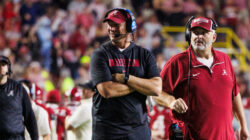Shane Ray and Braylon Webb, returning starters for Missouri this season, walked off the Georgia Dome turf out of breath last December after an emphatic 59-42 loss to Auburn in the SEC Championship Game.
The pair tirelessly chased Tre Mason from sideline to sideline as the league’s top back ran wild against the Eastern Division’s stingiest rushing defense, picking up yards in chunks en route to an individual title game record.
“There’s a real frustration that comes over you on defense when they’re coming after you over and over and over again,” Missouri’s Gary Pinkel told reporters. “We had trouble stopping it, obviously, and couldn’t get it fixed.”
Pinkel’s frustration was felt throughout his own division after its ego was bruised for a fifth consecutive season in Atlanta and sixth time in the last seven years. The Western Division’s relentless recent run resembles a runaway train screeching across tracks built by multiple Heisman Trophy winners and four BCS national champions.
With several of college football’s most respected coaches acting as conductors and Texas A&M sporting its new look as a successful SEC caboose, there no signs of it stopping.
SEC Championship Game results since 2007
- 2013: No. 3 Auburn 59, No. 5 Missouri 42
- 2012: No. 2 Alabama 32, No. 3 Georgia 28
- 2011: No. 1 LSU 42, No. 12 Georgia 10
- 2010: No. 1 Auburn 56, No. 19 South Carolina 17
- 2009: No. 2 Alabama 32, No. 1 Florida 13
- 2008: No. 2 Florida 31, No. 1 Alabama 20
- 2007: No. 5 LSU 21, No. 14 Tennessee 14
The West’s dominant stretch started in 2009 when Alabama got payback — and forced Tim Tebow’s memorable tears — against top-ranked Florida in a matchup that went the Gators’ way the previous season. The Crimson Tide’s return to prominence following Nick Saban’s arrival in 2007 is a major factor in that division’s strength.
In 2010, title game rookie South Carolina was pummeled by eventual national champion Cam Newton and Auburn, 56-17, despite being equipped with Marcus Lattimore and Alshon Jeffery — two of the best players in school history.
Coinciding with the West’s current streak, there hasn’t been a team in the East capable of matching Urban Meyer’s two-time national champion Gators — the last group to dethrone a member from the West in Atlanta.
The West’s 2012 acquisition of Texas A&M increased its footprint nationally and placed another ranked team in a competitive division. Thanks to Kevin Sumlin, the Aggies have already established a stable base, a process still in the works under new regimes at Florida and Tennessee.
Auburn’s rapid rise from the cellar under Gus Malzahn’s been a sizable shot to the arm for the East, not to mention that coming into this season, the SEC’s two most heralded incoming freshmen are both out West — LSU’s Leonard Fournette and Texas A&M’s Myles Garrett.
The Eastern Division’s heyday came in the 1990s when Steve Spurrier’s Gators, along with national power Tennessee, plowed through the competition after combining for six conference championships from 1993 to 1998.
Since Phillip Fulmer’s departure in 2008, Tennessee’s struggled for relevance and been no match for the West, going 1-11 against cross-division opponents. During that same span, the West is 58-29 against teams from the East.
Who’s better? The current state: SEC West vs. East
- Auburn > Georgia
- Alabama > South Carolina
- LSU > Florida
- Missouri > Ole Miss
- Texas A&M > Tennessee
- Vanderbilt = Mississippi State
- Arkansas = Kentucky
It’s simple — the West has a four-team edge going into this season and the only reason it’s not five is because Vanderbilt’s coming off back-to-back nine-win campaigns. Expectations are far greater however for Dak Prescott and the Bulldogs in comparison to first-year coach Derek Mason and the Commodores.
Success comes in cycles and the West has a chance to tie the East’s mid-90s stretch of dominance this fall should division favorites Alabama and Auburn stake their claim toward a berth in the first College Football Playoff.
South Carolina’s opener against Texas A&M is crucial to the East’s hopes at staying afloat on a competitive plane, at least early in the season. Falling further behind its rival division’s locomotive would cripple chances at a throne upheaval in December.
How bad would it look if the nation’s longest home win streak was snapped at the hands of a program picked to finish 6th in the West?







